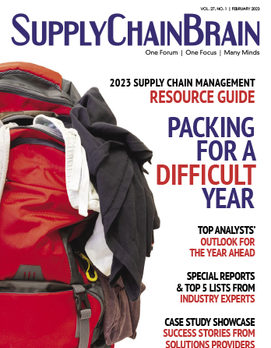
Home » Why Warehouse Managers Need to Keep a Keen Ear for Workers’ Everyday Problems
Why Warehouse Managers Need to Keep a Keen Ear for Workers’ Everyday Problems

Two workers review documents in a warehouse. Photo: Shutterstock.
August 9, 2022
We don’t have enough workers to operate critical supply chain facilities -- warehouses, distribution centers and even trucks. That means we need greater productivity, which in turn means driving continuous improvement in the workplace. But while we’re embracing this lean, super-productive mindset, it’s absolutely imperative that we pay heed to the psychological welfare of workers.
Of course, this is a good idea in terms of overall human happiness, but it’s extremely good for business, too. In fact, a psychologically smart approach to management is going to become more and more of a competitive advantage in a cut-throat world, says Steve Holic, Chief Executive Officer and Founder at Holic Supply Chain Solutions, LLC.
That’s because the people on the floor, the folks who pick and pack your orders, and the men and women who drive the trucks that make your deliveries all know the problems that are making your business less efficient than it could be. And if you can get them to tell you those problems, instead of finding themselves in a culture that encourages covering them up or making quick, one-time fixes, you can find yourself well on the way to a continuous improvement profile that would make a McKinsey consultant gasp in admiration.
Quick fixes that cost time
“What usually happens is that someone encounters a problem, and they decide to just fix it for this one shipment,” says Holic. But when employees are encouraged to stop and figure out if the problem they’re fixing on the fly is something that occurs regularly, they can help save your business surprising amounts of time and money. That’s because a 30-second workaround, such as fixing an error with labeling by reprinting, for example, begins to add up pretty fast if it’s repeated dozens of times a day. “If you can make a delivery in 5 minutes, that’s great, but if you’re there for two hours because the delivery slip doesn’t match the PO, there’s a huge cost there,” says Holic. He points out that the COVID-19 pandemic really highlighted this aspect, because there were so many extra steps and protocols being introduced along the supply chain and delivery process – temperature checks, remote signatures and so on. Further, pandemic or not, delivery operations have become more complex, with tasks assigned to drivers such as taking a photo of a delivery’s location. The more steps and requirements there are, the more chance there is of encountering a snafu or at the very least a delay. And that can have a profound effect on operations.
“Productivity is the key to success, and it starts with small incremental steps every day. Saving a minute here and there has monumental implications when applied across the network,” says Holic. “But you have to get it documented and you have to get people to open up. If someone tells you they don’t know how to do something, say ‘thank you very much.’ Because if somebody finds themselves in a group of 25 colleagues, and someone is snickering and saying ‘you should know how to do that,’ that creates an unsafe environment. That person is not going to tell you that he made a mistake. We want people to tell us their failures, so you can do something about it -- add it to training, or get to the source of the problem.”
Holic says the industry is rife with quirks and workarounds that may make sense at the individual level, but cost businesses dear in the wider environment, and in the long term. He has a cornucopia of salutary tales of folly. The forklift driver who hides his forklift over lunch because he doesn’t want anyone else to use it. Or the picker who hides his favorite scanner from the shared collection after use because he wants to be sure she’ll have access to it later. “This doesn’t help anybody. Maybe a solution is to give people their own scanner,” he says. If that sounds petty, just consider how much inefficiency ignoring such a habitual problem can cause. “So often, it’s tiny things that make a difference.” It’s big things, too, of course. For example, a warehouse supervisor might know exactly where all the pallets and orders are at any given moment, and doesn’t want to spend the time in a super-busy environment to keep documentation up to date. But what if that person goes sick? “I understand that it’s going to add three minutes to end of your day to put a colored cone on a pallet, but it’s not for you. It’s for the next guy,” Holic says.
Reducing errors in picking, shipping and delivery is all about daily management, Holic argues. “I don’t believe in monthly management or monthly business reviews. The data’s too old to actually create opportunities for actions, and it means you’re always looking backwards,” says Holic. “I would always want to look forward, or as much in real time as possible, in order to make adjustments. Sure, monthly, quarterly and yearly reports allow you to run analytics that reveal trends, so you can see if you’re actually making improvements. “With that data, you can see the trend, but you should still be driving change on the daily level, and seeing it in the daily report. Monthly meetings are not the be-all-end-all.”
Get everyone to think systemic, and reward them for doing so
Then, it’s critical for managers to look at any issues from daily management, and identify whether this is a problem across the network, or in a particular geographic area, or with an individual customer. That means fostering a mindset amongst all workers that encourages thinking big. “If you’re having this problem and this is a global or national shipper, you have to figure someone’s probably having this same problem elsewhere,” Holic says. “And, by the way, that’s why getting it all digitized is key.”
Holic whole-heartedly recommends introducing a Reward and Recognition Program for employees who identify and report problems, or opportunities to make processes more efficient. “Every facility should have one,” Holic says. “It increases the employee’s desire to stay with you because they feel rewarded and valued for the work they do.”
Job definition, opportunities for advancement, and training are also very important, Holic says. “It starts with the job description. That should be clear. Then you want to establish what are your employee’s goals, how are they measured, and where do they want to go in two, three, five, ten years. Some people don’t want to grow, but you need to identify who wants to move on from working with a truck twenty years from now. Because it is grueling work, in the hot and the cold. At least you can create an awareness of possibility, and provide education.”
As for training, many companies skimp on it because of the typical turnover rates in the industry. “Some companies are worried that they might train someone, only to see them leave in a year. Well, I say, maybe, but maybe he’d leave in six months if you don’t train him. And anyway you’ll benefit while he’s here.”
Holic acknowledges that people don’t stay in the same job, with the same company for 30 years anymore. “We do need to standardize the work, and document it, and collect and use tribal knowledge,” he says. “We have to make sure we get this stuff written down. And not everyone’s going to read a manual, so shoot a video!”
RELATED CONTENT
RELATED VIDEOS
Subscribe to our Daily Newsletter!
Timely, incisive articles delivered directly to your inbox.
Popular Stories

2023 Supply Chain Management Resource Guide: Packing for a Difficult Year
VIEW THE LATEST ISSUECase Studies
-
JLL Finds Perfect Warehouse Location, Leading to $15M Grant for Startup
-
Robots Speed Fulfillment to Help Apparel Company Scale for Growth
-
New Revenue for Cloud-Based TMS that Embeds Orderful’s Modern EDI Platform
-
Convenience Store Client Maximizes Profit and Improves Customer Service
-
A Digitally Native Footwear Brand Finds Rapid Fulfillment



